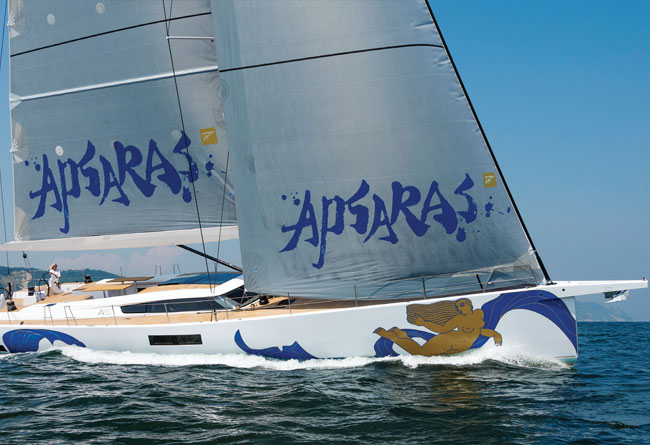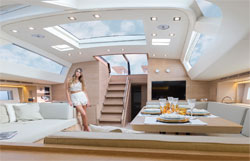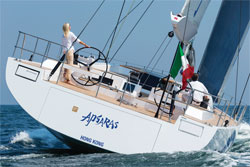

The sea trials of the first Advanced 80 from Italian shipyard Advanced Yachts can only be described as rigorous… three years in and counting
'After the launch in summer 2015 she crossed the Atlantic and won the ARC’s Cruising A category on elapsed time, then cruised in the BVI before coming back to the Med for summer 2016,’ explains Luca Pedol of the A80 stylists Nauta Yachts. Then she sailed across the Atlantic again in 2016 and cruised in Brazil, South Africa, Madagascar, the Seychelles and Thailand. She’s now in the Philippines, where she won the Commodore’s Regatta in April.
Three years in and her sea trials continue. Her itinerary for 2018 is Malaysia, Indonesia, Australia and New Zealand. From there she will cross the South Pacific to Chile, then cruise up the Pacific coast to Vancouver, southwest to Hawaii, on to the Marshall Islands and Japan before finally reaching her home port of Hong Kong.
‘Several ocean passages and hard-fought regattas have proved the stiffness and reliability of the construction,’ says Pedol. ‘The yacht is still in mint condition and the owner is completely satisfied.’
The boat behaved beautifully on the trip to Cape Town. With the exception of 30 hours under power, the crew were able to sail all the way – a total of 21,000 miles. During the trip they faced all sorts of weather conditions, including some very tough ones, and the boat was very well balanced and easy to handle, with the crew always feeling extremely safe.
Those tough conditions included three days in the Med in 40kt TWS, gusting 50, and reaching 25kt of boatspeed under triple-reefed main and staysail in 40-45kt on the passage to South Africa. The A80 is without doubt a blue water thoroughbred, so how did her story start?
When Advanced Yachts settled on the concept of a blue water performance cruiser that could eat up the ocean miles at pace as well as in comfort, safety and style, it turned to the formidable ‘A Team’ behind its A66. Jim Pugh of Reichel/Pugh Yacht Design would take care of naval architecture. Interior and exterior styling fell to Mario Pedol and Massimo Gino of Nauta Yachts, and Gurit took charge of the structural engineering.
The process started with styling as the boat’s proportions and volume requirements would dictate the naval architecture. ‘Nauta Yachts of Milan were chosen to develop the concept of the exterior and interior of the yacht,’ says Jim Pugh. ‘The parameters drawn up by Nauta Yachts include the beam and draft, which then determines the displacement given the materials they would use to construct the A80. Around those parameters we developed the naval architecture, hull shape, appendages and sail plan to develop a clean, fast, sea-kindly design.’
‘High performance and high volume were the targets for naval architects Reichel/Pugh in designing the hull,’ explains Pedol. ‘The rudder shape and the fin profile are the result of state-of-theart in-house research to deliver high speed, and to give the helmsman total control of the yacht and easy handling under sail in any weather conditions. Maximum beam comes all the way aft to provide plenty of volume for interior layouts that can adapt to meet all the requirements of Advanced Yachts’ experienced and demanding customers.’

The raised saloon contributes to the Advanced 80’s distinct Nauta signature with the emphasis on combining very light spaces below with a clean and modern external profile above deck. The interior ‘skylights’ are a particularly attractive feature that will no doubt soon be reproduced elsewhere…

Pugh took care to avoid extremes with this design, as he needed to deliver an all-rounder, a hull that would perform well in the full range of conditions any ocean-going boat could expect to experience. The result is an easily driven hull shape with a 3.5m fin and bulb keel and a single composite rudder.
‘With a moderate all-round hull shape, twin rudders are not advantageous,’ Pugh says. ‘Twin rudders are well suited to lightdisplacement Open 60 or Volvo Ocean 65 wide-stern designs with submerged transoms that spend long periods at high heel angles. Even downwind those boats sail high angles so the weather rudder is more often out of the water. On a moderate-displacement clean transom hull shape we don’t want to be dragging a second rudder through the water most of the time, which in fact provides less control, not more. The single rudder does a great job.’
For its part Nauta did what it does best. ‘Our design philosophy is based on clean lines and smooth, uninterrupted flow between interior and exterior,’ says Pedol. ‘The main inspirations that drove Nauta’s work in the A80 design were comfort, elegance and allure combined with functionality and efficiency.’
In keeping with the semi-custom nature of the A80, Nauta worked with the Advanced Yachts design team to offer three interior layouts. ‘The first hull, Apsaras, has the owner’s suite aft,’ he explains. ‘It’s a full-beam cabin with two ensuite bathrooms, a king-sized double island berth and two side sofas or single beds. Two midships twin guest cabins with ensuite bathrooms complete the sleeping quarters. Amidships is the full-beam saloon with a large dining table to port and a huge sofa to starboard – something that has never been seen before on an 80ft performance sailing yacht. The galley is just forward and to port of that, with a crew mess to starboard and crew quarters, two ensuite Pullman cabins, are in the bow. We also developed a simple, innovative system to divide the owner’s suite into two smaller cabins.
‘The second layout has the owner’s suite forward, which features a large walk-in closet. There are two versions of this layout. The first is more traditional, with galley, chart table and two Pullman crew cabins aft. The second shows an American-style open space galley amidships, close to the saloon. Two guest cabins and one Pullman crew cabin are aft. Advanced Yachts also offer every owner further options for customisation, in the choice of timbers, the type of furnishings and fabrics, and other details. Every Advanced Yacht is uniquely special.’
Nauta’s designs always aim to minimise the separation between interior and exterior. ‘The saloon is as close as possible to the cockpit to create a seamless connection between outside and inside. The transparent glass companionway features another glass side section to increase further the feeling of flow between inside and out.’
On deck a sprayhood has been recessed into the coachroof to protect crew in the forward cockpit in wet or rough weather. Otherwise the design works to create living spaces that are defined, but not separated. ‘The very large cockpit features three different social spaces for owner and guests: forward is the wide dining area with two sofas and two extendable tables, there’s a relaxing area close to the sail-handling space and a sunbathing area on the stern, facing aft, equipped with removable chaises longues. This long and wide surface is designed to be on one level, with no large steps, no bulky superstructures, no obstacles to move around, and without affecting the generous volumes of the interior below.’
The skipper has twin wheels positioned well outboard for optimum visibility forwards and elegant low-profile coamings keep out any water on the sidedecks. The powered mainsheet winch is on a centreline pod just aft of the traveller, recessed into the deck. There are powered primaries on the coamings just forward of the wheels, and two powered halyard winches either side of the mast. This keeps lines in the aft cockpit to the bare minimum and creates a relaxing and family-friendly line-free area in the forward cockpit.
She’s driven by a three-spreader fractional rig by Hall Spars with a V-boom for her slab reefing, hydraulically adjusted split backstay and hydraulic vang. The non-overlapping jib has an electric furler recessed below the deck and downwind sails are flown from a sturdy fixed bowsprit that also incorporates the anchor roller.
In delivering the build structural engineers Gurit also needed to avoid extremes. They had to specify a boat that would be both lightweight and stiff enough to offer exciting performance, solid and reliable enough to emerge unscathed from oceanic storms, and offer the high-quality finish, comfortable ride and luxury that owners of the A80 expect.
For the A80’s hull and deck the choice was foam-cored GRP with additional GRP and unidirectional carbon-fibre reinforcement in areas of the highest load and greatest stress. The vacuum-infusion of epoxy resins was carefully controlled by the yard to ensure full impregnation, while keeping down the weight. ‘Hull and deck are built in CNC-machined female moulds, and the result is a very light hull with a perfect surface finish,’ adds Pedol. ‘This process guarantees optimised stiffness for the best performance, strength and durability.’
Now that the blue water credentials of the Advanced 80 have been conclusively proved (and then some), what are the plans? ‘The second build is almost completed and her launch is planned for summer 2018,’ Pedol concludes. ‘We look forward to seeing a big family of Advanced 80s in the water in the next few years, as this is a fantastic project that we loved designing!’.
Click here for more information on Advanced Yachts »
We invite you to read on and find out for yourself why Seahorse is the most highly-rated source in the world for anyone who is serious about their racing.
To read on simply SIGN up NOW
Take advantage of our very best subscription offer or order a single copy of this issue of Seahorse.
Online at:
www.seahorse.co.uk/shop and use the code TECH20
Or for iPad simply download the Seahorse App at the iTunes store


